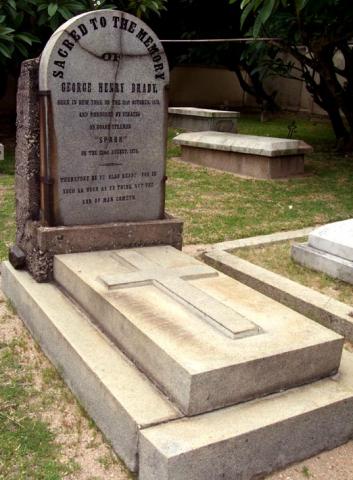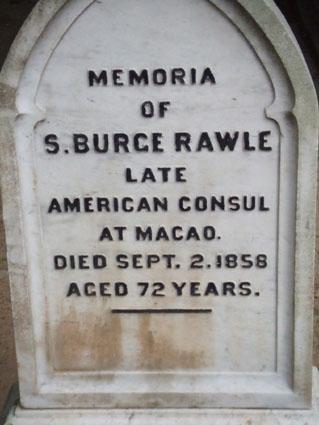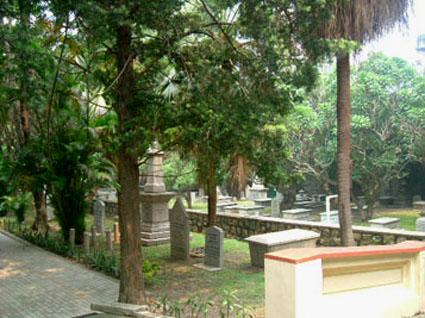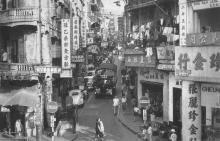Macau's Protestant Cemeteries
Primary tabs
It's hard to make a case for the joys of cemeteries without people looking at you a bit strange, and perhaps edging a bit further away. But let me try, with four reasons that cemeteries deserve your attention:
|
We'll use the Protestant Cemeteries in Macau as an example. I only heard about them recently, from Ms Shyama Peebles. Shyama has spent a lot of time and effort documenting the gravestones in each of the cemeteries, complete with photographs and typed copies of each stone's text. Click these links to download the results of her hard work:
- Graves in Macau's Old Protestant Cemetery (13Mb PDF file)
- Graves in Macau's New Protestant Cemetery (9Mb PDF file)
As you browse through them, consider ...
The story behind the cemetery
Macau was very definitely a Roman Catholic country. Which meant trouble if you were Protestant and had to deal with the death of a friend or family member. There was nowhere to bury them!
Wikipedia explains:
Macau was considered by the Portuguese to be sacred Roman Catholic ground and the authorities barred the burial of Protestants within its city walls, whilst on the other side of the barrier gate the Chinese were equally as intolerant of the burial of foreigners in its soil. This left the Protestant community of British, American and Northern European traders with the only option of a secret night-time burial in the land between the city walls and the barrier gate, and the risk of confrontation with Chinese should they be discovered, or worse, desecration of the grave once they had gone.
The matter was finally resolved in 1821 after the death of Robert Morrison's wife, Mary, when the local committee of the East India Company voted to purchase a plot of land and resolve its legal status with the Portuguese such that the burial of Protestants would be permitted there. Later, the East India Company allowed burial of all foreigners, and several graves were moved from other locations outside the city walls into the cemetery, explaining why some graves are dated before its founding in 1821. Nationals of Britain, the United States of America, Holland, Denmark, Sweden and Germany are buried there.
The cemetery was closed in 1858, after which the cemetery began to be referred to as the "Old" Protestant Cemetery.
The stories on the stones
Gravestones are the Twitter of the history world, with whole lifetimes compressed into just a few lines of text. But if you read them with a curious mind, I defy you to resist googling to find out more.
|
Cemeteries as a research tool
Those few lines of text can be a great help if you're trying to research your family history. They usually show dates of birth and death, and may also tell us where the person was born, who they married, what work they did, and how they died.
And for Hong Kong in particular, where so many of the oldest records have been lost, gravestones may be the only records we still have. That's especially true for Hong Kong's graveyards, but Macau's history was closely intertwined with Hong Kong's in those days. Though these stones are in Macau, they often have stories to tell about life in Hong Kong.
A quiet spot to visit
The photos show the cemteries as a quiet place to take a rest from the bustle of the city.
If you'd like to take a look next time you visit Macau, here are their locations. A is the old, and B is the new:





Comments
George Chinnery
Is also buried at the old Protestant Cemetery.
I can also recommend the St MIchael's RC church and cemetery, not too far away, although that one is brimming to the edges with graves.
re: George Chinnery
Hi Phil, I see you've also written about the old Protestant Cemetery and the Morrison Chapel next door. If you've got anything on new cemetery or St Michael's, please could you let us have the link?
Thanks, David
PS Chinnery's grave & plaque appears on page 22 of Shyama's PDF.
Macao Cemetery - Armenian graves
Having worked on a couple of thousand photographs of graves myself, I am full of admiration and praise for Shyama Peebles.
There are two Armenian graves (that I could see), that of C. Cachatoor who died in 1829 and Dishkoone Seth nee Marooth who died in 1857. I wonder if you would be kind enough to pass on a small correction please? Dishkoone's husband was Aviet Seth and not Anst SETH, as Shyama has noted it. Actually, his full name was Seth Aviet SETH and he is buried in Happy Valley cemetery, not far from the grave of Paul Chater. Seth Aviet SETH and Dishkoone were the proud parents of Arathoon SETH who became the Registrar of the Supreme Court in Hong Kong for many years.
Arathoon Seth's entry from Twentieth Century Impressions says: "Arathoon Seth is the Registrar of the Supreme Court, Hongkong. He was born in 1852. When only sixteen years of age he was appointed Hindustani interpreter to the Magistracy, Hongkong, having acquired a knowledge of the language in Hongkong, and, except for a comparatively short interval when he was attached to the Peninsular and Oriental Company, he has been in the Civil Service ever since. He re-entered the Magistracy as third clerk in September 1872, and received steady promotion, becoming the first clerk in 1875, and Clerk of Councils and chief clerk in the Colonial Secretary’s office six years later. He was created a Justice of the Peace in 1882, and was called to the Bar by Lincoln’s Inn in 1893. After serving as Superintendent of the Opium Revenue and of Imports and Exports was appointed Secretary to the Board, under the “Taipingshan Resumption Ordinance,” and subsequently received the thanks of the Government for his services. He has held a variety of other posts from time to time, including those of Acting Assistant Registrar-General, Official Receiver in Bankruptcy, Acting Registrar of the Supreme Court, Acting Land Officer, Acting Registrar of Companies, Official Administrator and Official Trustee; was appointed to his present position in October 1903. Mr. Seth is a member of the Hongkong Club and lives at Norman Cottage, Peak Road."
Liz
Armenian graves, and graves in general
Liz,
Thanks for the extra information, which Shyama found interesting.
I'm interested to know how you've stored all the information you've collected about graves. Do you keep it in your own records, or have you found a good public site to store it all on?
Shyama pointed out http://www.findagrave.com/, which already has a lot of Hong Kong's graves listed. I'm wondering whether there's any value in making it easy to record grave information here on gwulo.com, or if we should just link out to an external site like findagrave, or some combination of the two.
Suggestions welcome!
Regards, David
Graves - storing and recording details and information
Hi David,
You have asked an excellent question, which I shall attempt to answer.
As you may know, I have a project on the go at the moment to photograph, record, transcribe/translate Armenian graves in India before the climate erodes them to blank pieces of rock. Over the last 5 years I've made several research trips to India and have photographed nearly 4,000 graves.
I have put nearly 2,000 graves on my website as part of my project to assist other Armenian family history researchers with their own family history stories. I allow anyone to take as many copies as they wish and I HOPE that in turn they will make a donation to my research via PayPal. I'm way out of pocket on this - there have been no donations this year at all!
In terms of keeping details and storing information generally, I use an excellent piece of genealogy software which allows me to attach multimedia items and documents (such as copy birth certificates, or census documents etc), and this is where I keep the grave photographs. This software also has the facility to automatically create a website with the information and photographs kept in it. You are able to select as much or as little detail as you want made public, it is very versatile. It is called Family Historian V.4. Most family history software is based on US documents and census records, whereas F.H.4 is written specifically for the UK market and all its ancilliary historical information. Having said that, I don't use the "make website" facility on it only because I started my website years before I discovered F.H.4 and I've just stayed with what I do.
Re the website Find A Grave. I think its good, and have donated a couple of grave pictures to it (Sir Paul and his brother Joseph along with nephew Theo).
You probably know that the Hong Kong cemeteries have already been photographed and recorded in detail by Patrica Lim. Also there is a lady called Christine Thomas who offers a look up service and further details for a fee, as she too has a complete photographic collection of the graves.
If you're thinking of doing the graves of Hong Kong, you may want to try and make contact with these ladies (no point re-inventing the wheel!) and see if they wish to collaborate.
My feeling is that you may wish to link any graves you get pictures of to the Find A Grave site.
Hope this helps.
Liz
re: Graves - storing and recording details and information
Hi Liz,
Thanks for your detailed reply.
Based on your comments I'll go with recommending findagrave to store information about graves (ie photo & inscription).
Shyama mentioned it's not easy to add extra information on that site, eg if you want to add some history about the person. I think that's a strength for this site. So general information about a person could be stored here, with a link to Findagrave for information about the gravestone.
That could change if there's an offer of a lot of gravestone records, but as you say, no point reinventing the wheel.
Regards, David
PS For your own site, unfortunately donations are a hard way to raise money. It seems the most common approach is to provide two levels of access. So 'free' might show a thumbnail picture of the gravestone with the name of the person, then 'paid' would give access to a larger photo and a full copy of the inscription.
Sir Lindsay Ride
A earlier work by Sir Lindsay ride, et al
An East India company cemetery: protestant burials in Macao, ISBN 962 209 384 1
Cheers,
isdl
More history about the old cemtery
As well as the book isdl mentions, Shyama lists these two in her PDF:
Regards, David
Casa Garden was rented by British merchants
Macau
"Anyone who knows the paintings of George Chinnery will recognize many scenes in today's old town...
The following itinerary is a lengthy one, but you can select parts if time is short.
Begin at the Old Protestant Cemetery (his tomb is one of the most elaborate...also here is the Morrison grave that he painted in 1838)
... Chinnery arrived in Macau in 1825. He stayed until his death in 1852 and became the doyen of China Coast artists
...In his days, this area was something like a British enclave, because the Casa Garden was rented by British merchants, until the founding of Hong Kong...The garden, now Camões Garden, was a popular retreat, and Chinnery painted it many times, as he did the nearby Monte Fort and St. Paul's (his drawing of the church is one of the few showing it before the fire)
..."
http://www.macautourism.gov.mo/en/discovering/walking_tour.php#7